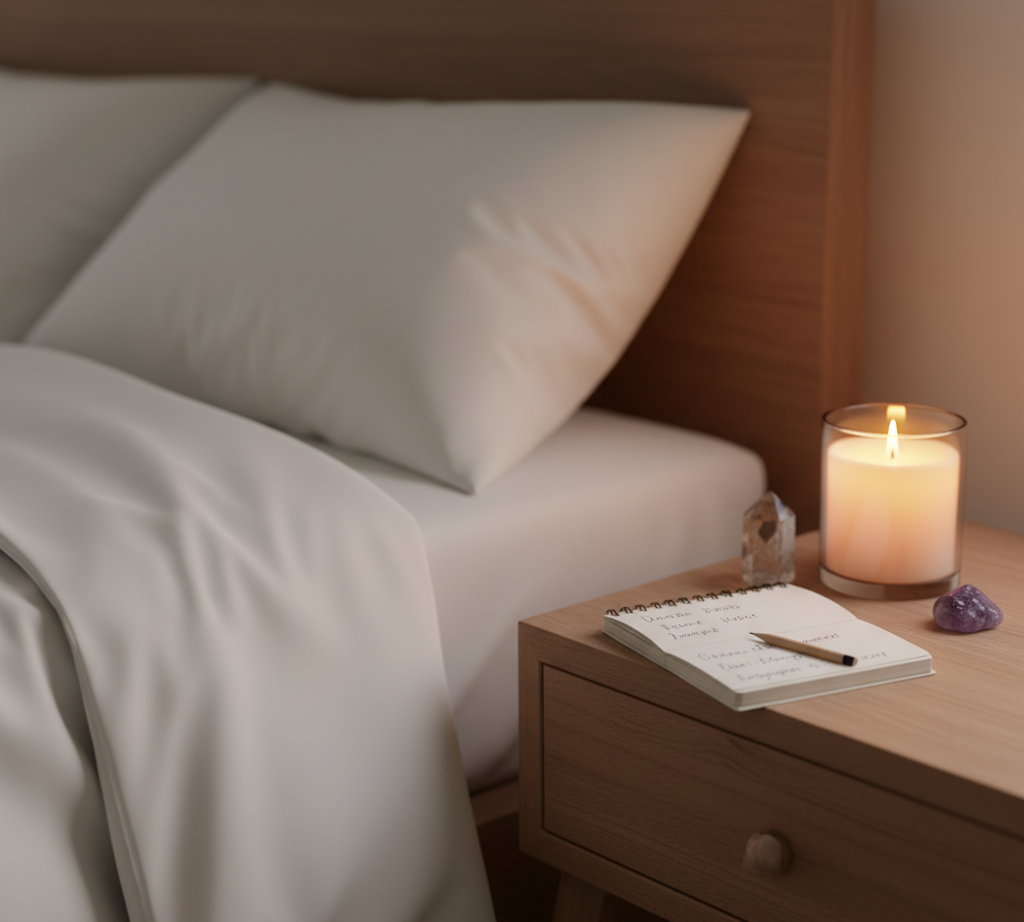Intro
Astral projection often sounds mysterious, but it doesn’t have to be. There’s a simple practice making waves online — the Head-Lift 30-Second Method — that blends lucid dreaming for energy work with easy, everyday awareness. If you’ve ever wondered how dreams and spiritual growth connect, or how to move from dream awareness techniques into an out-of-body experience, this guide will help you explore safely and with curiosity.
Why Astral Projection Draws So Much Interest

People are fascinated by astral projection because it offers a chance to explore consciousness beyond physical limits. Many who practice say it supports personal insight, healing, or just a deeper sense of wonder. It’s also closely linked to lucid dreaming for energy work — both rely on noticing the space between waking and sleeping and using it to access higher clarity.
With the right mindset, these practices aren’t about escape; they’re about getting to know yourself better, learning how energy moves, and strengthening focus in daily life.
The Head-Lift Technique: Step by Step
This method, created by Reddit user “Total-Interview8697” is gaining attention because of its simplicity. Here’s how to try it:
Prep: the night before (set the stage)

Before going to sleep, craft a short, clear intention you can easily recall when half-awake. A simple line works best — something like, “When I wake, I’ll gently lift my head and notice what happens.” Say it quietly to yourself or aloud as you settle into bed. The point is to keep the message brief enough that it sticks, even in a groggy state.
Set up your environment so it naturally supports the practice. Keep the room dim and comfortable, and make sure the temperature feels pleasant. If you use your phone as an alarm, place it far enough away that you won’t grab it impulsively when you wake. Choose a soft tone for your wake-up cue so you don’t jolt yourself fully alert before you get a chance to explore.
Because this approach often works best during REM cycles, aim to try it after you’ve been asleep for about four to six hours. If you’d like extra structure, set a gentle alarm for roughly the five- or six-hour mark to catch yourself in that ideal window. Just make sure the sound is subtle — you want to rise toward awareness without losing the dreamy edge completely.
Finally, prepare a tiny notebook or journal and place it by your bed. Write your one-line reminder — “Lift head slowly.” — on an index card or sticky note and leave it beside your journal. This little cue reinforces your intention, and the notebook is there to capture whatever insights, images, or sensations you remember when the session ends.
Micro-techniques you’ll use (practice these once or twice while awake)
To get comfortable with the movement you’ll use later, try a mini-lift drill while lying on your back. Let your head rest naturally on the pillow and notice how it indents beneath the weight. Then, ever so slightly, lighten that pressure — just enough that the pillow feels a touch less compressed, no more than a centimeter. It’s a micro-movement rather than a full lift. Practicing this tiny shift during the day trains your muscles to remember it, so when you’re half-asleep it feels natural instead of clumsy.
Pair that practice with slow-count breathing to keep your body relaxed and your mind clear. Breathe in gently for a count of four, hold for one beat, then release the air in a long six-count exhale. This simple rhythm lowers adrenaline and helps you stay balanced between wakefulness and sleep, which is exactly where you want to be for astral work.
Finally, choose a clarity cue — a short phrase you can repeat if things get fuzzy once you’re “out.” Words like “Clarity now” or “Steady” work well because they’re easy to remember and carry a grounding effect. Saying them a few times in waking life creates a fast anchor you can call on later if your focus starts to drift during the experience.
The core Step-by-Step (what to do once you wake)

The first moment you become aware you’re awake, don’t move. Keep your eyes closed and mentally repeat your intention: “Lift head slowly.” This flicker of awareness is your window to begin the process, so resist the urge to shift or react.
Once you’ve caught that moment, focus on stabilizing the liminal state. Keep breathing gently using your slow-count rhythm, and remind yourself it’s okay to be half-awake. If you feel startled, rest a hand lightly on your chest while staying physically still — this helps soften the jolt of waking and brings calm to your system.
Next comes the micro-lift. Move incredibly slowly, like lifting a feather, so subtle that it might barely be noticeable to someone watching. Your goal is the combination of intention and micro-pressure rather than a full sit-up. Keep your neck and shoulders relaxed, and maintain natural breathing as you execute the motion.
As you lift, pay attention for signs of float or shift — a sense of lightness, warmth, slight pops, vibrations, or changes in sound. If something moves, don’t get excited. Keep breathing steadily, and repeat your clarity cue, like “Clarity now,” to stay grounded in the half-asleep state.
If your head feels weightless and ready to “exit,” follow gently. Imagine the rest of your body gliding along, maintaining the same slow, deliberate intention. Some experience a quick whoosh once fully detached — that’s normal. If you tumble or find yourself beside the bed, pause, breathe, and steady yourself before continuing.
After the exit, stabilize and explore. Whether you sit or stand in the astral, use micro-actions to clarify perception: rub your hands together, touch the floor, or look at a corner in the room. Move slowly, and if fear or excitement arises, focus on a neutral sensory detail to maintain calm.
Finally, when it’s time to return, set the intention “back now” or simply think of your physical body. Wiggle a finger or take a deep breath before opening your eyes. Immediately jot down any impressions, even single words, so you don’t lose the subtle details of the experience.
Variations, feelings and integration.
If the head-lift method isn’t working, you can try some variations. A slow roll lets you gently roll your dream-body to the side instead of lifting your head. Some succeed with a micro sit-up, a tiny upper-body lift, or an arm extension, imagining a phantom wiggle before following with the rest of the body. If you feel stuck, an aggressive mental push — strong intent, not physical effort — can help.
During attempts, you might notice tingles, vibrations, or a rush/ whoosh. Stay calm, breathe, and use your clarity cue. For partial exits, visualize rolling the stuck parts out. If fear or heart racing appears, focus on breath and think “steady”.
Practice 2–4 times per week for 5–20 minutes. Keep a simple log of what worked and what you felt; patterns appear fast. Progress varies — some succeed on the first night, others after weeks. Consistency and calm practice beat force.
After an exit, journal impressions, reflect on sensations, and do an energy check. Subtle warmth or tingling can indicate shifts in your field. Exercises in Mastering Energy Reading can help you interpret these sensations and build stability for future practice (book link).
Troubleshooting table (quick reference)
| Problem | Likely cause | Try this |
|---|---|---|
| I forgot when I woke | weak pre-sleep intention | put a note by bed + voice cue |
| Moved too much, woke fully | sudden physical motion | rehearse micro-lift; lower alarm intensity |
| Too excited, snapped back | adrenaline | breathe, repeat “steady” |
| Partial vibrations only | timing or micro-movement off | micro-practice + try WBTB |
| Feel stuck or fearful | lack grounding | rub astral hands, focus on a neutral object |
Why Timing Matters
Science on astral projection is still limited, but many agree that the state matters most. Right after waking, your brain may still be in REM, where lucid dreams occur. Muscles remain relaxed, while awareness is sharp — perfect for stepping into a more energetic space.
Some describe this as aligning physical rest, mental clarity, and spiritual openness. When these layers sync, moving into an astral state feels natural.
Connecting with Your Energy Field

Tuning into your energy makes astral projection steadier. Learning to read subtle cues — warmth, tingles, or emotional tones — helps you feel safer and more grounded. Yair’s book, Mastering Energy Reading, is packed with exercises to recognize and interpret these signals. Many readers find their dream and astral practices become clearer once they understand their personal energy patterns.
Integrating Lessons into Daily Life
Astral projection isn’t about leaving reality behind. It’s an extension of mindfulness. When you bring back what you learn — calm focus, creative insight, or a refreshed sense of purpose — you make both worlds richer. Keeping a journal after each attempt can help capture impressions before they fade.
You might also notice everyday improvements: easier meditation, steadier moods, or more creativity. This is where lucid dreaming for energy work meets real-world benefits.
FAQ: Astral Projection Common Misconceptions

Is this safe?
For most people, yes: this is a low-risk, low-effort awareness exercise. It’s essentially an exploration of the sleep/wake boundary and states of consciousness. If you have a history of severe insomnia, trauma tied to sleep, or dissociation, take extra care — consult a trusted practitioner or clinician before experimenting. Stop if it heightens anxiety or disrupts healthy sleep.
How quickly will I succeed?
It varies. Some people report success on the first night; others need days or weeks. The most consistent factor is calm, regular practice and a clear but relaxed intention. Progress can show as subtle sensations (vibrations, lightness) before a full exit.
Do I need to be spiritual or believe in astral projection?
No. Skepticism does not block the basic mechanics — the method uses physiological moments (REM/half-wake) and gentle intention. Belief can make the experience more meaningful, but openness and relaxed curiosity are the most helpful attitudes.
Is this the same as lucid dreaming?
They overlap. Lucid dreaming is awareness within a dream; the head-lift often uses the moment between dreaming and waking (a REM-adjacent state). Some people move from lucid dreams into astral-type experiences; others have out-of-body sensations without dreaming. Both are useful dream awareness techniques.
What if I get scared while out there?
Stay calm, breathe, and bring attention to a neutral, stable object — rub your hands, focus on floor texture or a corner. If fear persists, set the intention to return and gently direct your attention back to the body. Remember: you are always in charge of your attention.
Can I do this during short naps?
Yes. Short naps that include REM can offer the same 30-second window. Naps can be a good low-pressure way to practice.
Do I need special equipment or rituals?
No. A notebook, a quiet environment, and a simple intention are enough. Tools (soft voice memo, candle, mild grounding routine) can help, but they’re optional.
Why the head first?
Many practitioners feel awareness is seated behind the eyes; nudging the head may be an efficient “lead” for the subtle body. It’s also an easy micro-movement that won’t fully engage physical musculature if done slowly.
What sensations are normal?
Tingling, buzzing, warmth, lightness, sound changes, mild shifts in temperature, a sense of rolling or floating — these are common. They’re not harmful; treat them as data, not danger.
Can you get stuck outside and not be able to return?
No credible evidence suggests permanent separation. Most people return by intention or simple physical movement (deep breath, wiggle). If you ever feel uncomfortable, focus on breath and safe, simple return cues.

Final Thoughts
The Head-Lift 30-Second Method shows that exploring consciousness doesn’t need complicated rituals or years of training. A gentle head lift during the fragile space between sleep and waking could open doors to astral projection via lucid dreams, or simply give you a deeper feel for your own energy.
This method is gentle, surprisingly accessible, and a great bridge between dream awareness techniques and more advanced explorations like astral projection via lucid dreams. Treat it as a playful practice: some mornings will surprise you, others will simply teach you how your attention and body relate. Keep a soft mindset, track your attempts, and let curiosity lead.
Treat it as an experiment in curiosity. Some mornings you’ll glide free, others you’ll just learn how awareness and body interact. Either way, you’re sharpening sensitivity and giving yourself a playful tool for dreams and spiritual growth.
Subscribe
If this guide sparked something in you, we invite you to stay close. Subscribe to our newsletter for more insights on psychedelic therapies, guided practices, and upcoming events that support your energy awareness and spiritual growth.
If you’d like to support us, please subscribe to our YouTube channel, buy me a coffee, or join our Aura Community.










